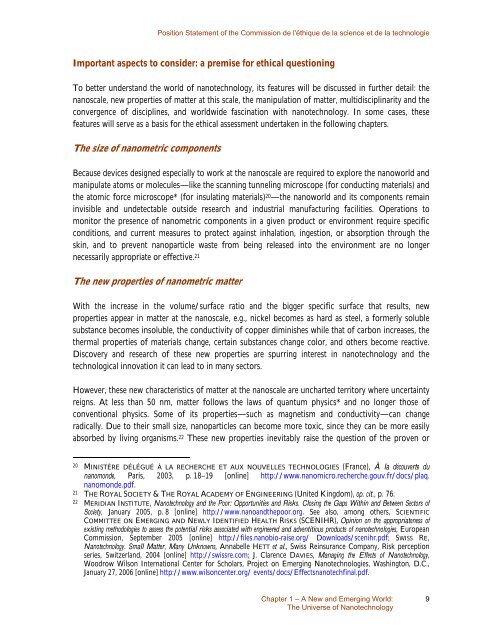A Basis for Action - Commission de l'éthique de la science et de la ...
A Basis for Action - Commission de l'éthique de la science et de la ...
A Basis for Action - Commission de l'éthique de la science et de la ...
You also want an ePaper? Increase the reach of your titles
YUMPU automatically turns print PDFs into web optimized ePapers that Google loves.
Position Statement of the <strong>Commission</strong> <strong>de</strong> l'éthique <strong>de</strong> <strong>la</strong> <strong>science</strong> <strong>et</strong> <strong>de</strong> <strong>la</strong> technologie<br />
Important aspects to consi<strong>de</strong>r: a premise <strong>for</strong> <strong>et</strong>hical questioning<br />
To b<strong>et</strong>ter un<strong>de</strong>rstand the world of nanotechnology, its features will be discussed in further <strong>de</strong>tail: the<br />
nanoscale, new properties of matter at this scale, the manipu<strong>la</strong>tion of matter, multidisciplinarity and the<br />
convergence of disciplines, and worldwi<strong>de</strong> fascination with nanotechnology. In some cases, these<br />
features will serve as a basis <strong>for</strong> the <strong>et</strong>hical assessment un<strong>de</strong>rtaken in the following chapters.<br />
The size of nanom<strong>et</strong>ric components<br />
Because <strong>de</strong>vices <strong>de</strong>signed especially to work at the nanoscale are required to explore the nanoworld and<br />
manipu<strong>la</strong>te atoms or molecules—like the scanning tunneling microscope (<strong>for</strong> conducting materials) and<br />
the atomic <strong>for</strong>ce microscope* (<strong>for</strong> insu<strong>la</strong>ting materials) 20 —the nanoworld and its components remain<br />
invisible and un<strong>de</strong>tectable outsi<strong>de</strong> research and industrial manufacturing facilities. Operations to<br />
monitor the presence of nanom<strong>et</strong>ric components in a given product or environment require specific<br />
conditions, and current measures to protect against inha<strong>la</strong>tion, ingestion, or absorption through the<br />
skin, and to prevent nanoparticle waste from being released into the environment are no longer<br />
necessarily appropriate or effective. 21<br />
The new properties of nanom<strong>et</strong>ric matter<br />
With the increase in the volume/surface ratio and the bigger specific surface that results, new<br />
properties appear in matter at the nanoscale, e.g., nickel becomes as hard as steel, a <strong>for</strong>merly soluble<br />
substance becomes insoluble, the conductivity of copper diminishes while that of carbon increases, the<br />
thermal properties of materials change, certain substances change color, and others become reactive.<br />
Discovery and research of these new properties are spurring interest in nanotechnology and the<br />
technological innovation it can lead to in many sectors.<br />
However, these new characteristics of matter at the nanoscale are uncharted territory where uncertainty<br />
reigns. At less than 50 nm, matter follows the <strong>la</strong>ws of quantum physics* and no longer those of<br />
conventional physics. Some of its properties—such as magn<strong>et</strong>ism and conductivity—can change<br />
radically. Due to their small size, nanoparticles can become more toxic, since they can be more easily<br />
absorbed by living organisms. 22 These new properties inevitably raise the question of the proven or<br />
20 MINISTÈRE DÉLÉGUÉ À LA RECHERCHE ET AUX NOUVELLES TECHNOLOGIES (France), À <strong>la</strong> découverte du<br />
nanomon<strong>de</strong>, Paris, 2003, p. 18–19 [online] http://www.nanomicro.recherche.gouv.fr/docs/p<strong>la</strong>q.<br />
nanomon<strong>de</strong>.pdf.<br />
21 THE ROYAL SOCIETY & THE ROYAL ACADEMY OF ENGINEERING (United Kingdom), op. cit., p. 76.<br />
22 MERIDIAN INSTITUTE, Nanotechnology and the Poor: Opportunities and Risks. Closing the Gaps Within and B<strong>et</strong>ween Sectors of<br />
Soci<strong>et</strong>y, January 2005, p. 8 [online] http://www.nanoandthepoor.org. See also, among others, SCIENTIFIC<br />
COMMITTEE ON EMERGING AND NEWLY IDENTIFIED HEALTH RISKS (SCENIHR), Opinion on the appropriateness of<br />
existing m<strong>et</strong>hodologies to assess the potential risks associated with engineered and adventitious products of nanotechnologies, European<br />
<strong>Commission</strong>, September 2005 [online] http://files.nanobio-raise.org/ Downloads/scenihr.pdf; SWISS RE,<br />
Nanotechnology. Small Matter, Many Unknowns, Annabelle HETT <strong>et</strong> al., Swiss Reinsurance Company, Risk perception<br />
series, Switzer<strong>la</strong>nd, 2004 [online] http://swissre.com; J. C<strong>la</strong>rence DAVIES, Managing the Effects of Nanotechnology,<br />
Woodrow Wilson International Center <strong>for</strong> Scho<strong>la</strong>rs, Project on Emerging Nanotechnologies, Washington, D.C.,<br />
January 27, 2006 [online] http://www.wilsoncenter.org/ events/docs/Effectsnanotechfinal.pdf.<br />
Chapter 1 – A New and Emerging World: 9<br />
The Universe of Nanotechnology
















